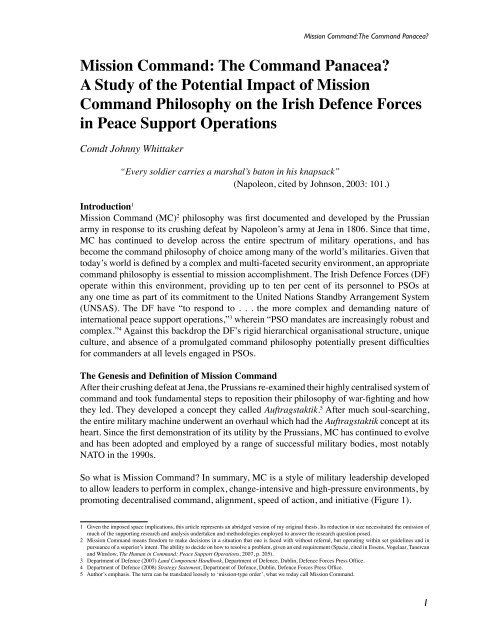Defence Forces Review 2010
Defence Forces Review 2010
Defence Forces Review 2010
Create successful ePaper yourself
Turn your PDF publications into a flip-book with our unique Google optimized e-Paper software.
Mission Command: The Command Panacea?Mission Command: The Command Panacea?A Study of the Potential Impact of MissionCommand Philosophy on the Irish <strong>Defence</strong> <strong>Forces</strong>in Peace Support OperationsComdt Johnny Whittaker“Every soldier carries a marshal’s baton in his knapsack”(Napoleon, cited by Johnson, 2003: 101.)Introduction 1Mission Command (MC) 2 philosophy was first documented and developed by the Prussianarmy in response to its crushing defeat by Napoleon’s army at Jena in 1806. Since that time,MC has continued to develop across the entire spectrum of military operations, and hasbecome the command philosophy of choice among many of the world’s militaries. Given thattoday’s world is defined by a complex and multi-faceted security environment, an appropriatecommand philosophy is essential to mission accomplishment. The Irish <strong>Defence</strong> <strong>Forces</strong> (DF)operate within this environment, providing up to ten per cent of its personnel to PSOs atany one time as part of its commitment to the United Nations Standby Arrangement System(UNSAS). The DF have “to respond to . . . the more complex and demanding nature ofinternational peace support operations,” 3 wherein “PSO mandates are increasingly robust andcomplex.” 4 Against this backdrop the DF’s rigid hierarchical organisational structure, uniqueculture, and absence of a promulgated command philosophy potentially present difficultiesfor commanders at all levels engaged in PSOs.The Genesis and Definition of Mission CommandAfter their crushing defeat at Jena, the Prussians re-examined their highly centralised system ofcommand and took fundamental steps to reposition their philosophy of war-fighting and howthey led. They developed a concept they called Auftragstaktik. 5 After much soul-searching,the entire military machine underwent an overhaul which had the Auftragstaktik concept at itsheart. Since the first demonstration of its utility by the Prussians, MC has continued to evolveand has been adopted and employed by a range of successful military bodies, most notablyNATO in the 1990s.So what is Mission Command? In summary, MC is a style of military leadership developedto allow leaders to perform in complex, change-intensive and high-pressure environments, bypromoting decentralised command, alignment, speed of action, and initiative (Figure 1).1 Given the imposed space implications, this article represents an abridged version of my original thesis. Its reduction in size necessitated the omission ofmuch of the supporting research and analysis undertaken and methodologies employed to answer the research question posed.2 Mission Command means freedom to make decisions in a situation that one is faced with without referral, but operating within set guidelines and inpursuance of a superior’s intent. The ability to decide on how to resolve a problem, given an end requirement (Spacie, cited in Essens, Vogelaar, Tanercanand Winslow, The Human in Command: Peace Support Operations, 2007, p. 205).3 Department of <strong>Defence</strong> (2007) Land Component Handbook, Department of <strong>Defence</strong>, Dublin, <strong>Defence</strong> <strong>Forces</strong> Press Office.4 Department of <strong>Defence</strong> (2008) Strategy Statement, Department of <strong>Defence</strong>, Dublin, <strong>Defence</strong> <strong>Forces</strong> Press Office.5 Author’s emphasis. The term can be translated loosely to ‘mission-type order’, what we today call Mission Command.1
















